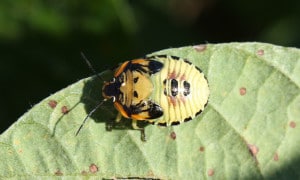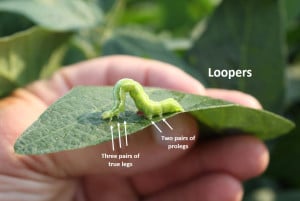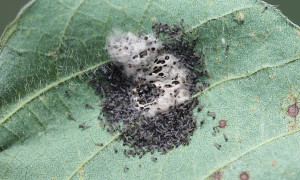Cotton: Making insecticide applications for cotton insects at this late date is not recommended, and most folks have rightly “walked away” from fields and turned their attention to corn and soybean harvest. It is now 25 or more days past the last effective bloom date (August 15 based on an average, historical frost date of October 15). Given some decent temperatures during this past 25 days, the last effective blooms have accumulated over 400 DD60s). It is time to terminate insecticide applications even for late fields that did not reach cutout until after August 15.
Soybean: Although some early maturing fields are ready for harvest, late maturing fields are hitting prime time for potential insect infestations. It may not be convenient, but we need to keep an close eye on fields that have not yet reached R6. It is these fields that we often see a late blow up of stink bugs and defoliating caterpillars such as loopers. Below are a couple of reminders.
-

Immature Green Stink Bug Stink Bugs – Prior to R6, treat when an average of 9 or more stink bugs are found per 25 sweeps. Double this threshold once you reach R6 for the next 7-10 days, and do not treat for stink bugs after this point. If there are low pest populations present at R6, it is very unlikely you will have a significant insect problem after this point. I often tell consultant and scouts they can walk away from “clean fields” once they reach R6.
 Loopers – Treat for loopers or other defoliating pests up to R6 when they cause 20-25% defoliation of more. An alternative threshold for loopers is to treat when 19 or more larvae are found per 25 sweeps. It is usually suggested that you ignore small larvae (< 1/4 inch) in these counts because they eat little and often have a high mortality rate. Once reaching R6, relax the treatment threshold to 30-40% for the next 7-10 days. Do not treat soybean fields for defoliating pest after this point … they are going to defoliate themselves! Remember that pyrethroid insecticides are not recommended for control of soybean loopers. Rather, products such as Belt, Besiege, Intrepid, Intrepid Edge, and Prevathon are recommended. I’ve not had reports of soybean loopers at treatment levels at this time, but we are finding more loopers and populations can build quickly.
Loopers – Treat for loopers or other defoliating pests up to R6 when they cause 20-25% defoliation of more. An alternative threshold for loopers is to treat when 19 or more larvae are found per 25 sweeps. It is usually suggested that you ignore small larvae (< 1/4 inch) in these counts because they eat little and often have a high mortality rate. Once reaching R6, relax the treatment threshold to 30-40% for the next 7-10 days. Do not treat soybean fields for defoliating pest after this point … they are going to defoliate themselves! Remember that pyrethroid insecticides are not recommended for control of soybean loopers. Rather, products such as Belt, Besiege, Intrepid, Intrepid Edge, and Prevathon are recommended. I’ve not had reports of soybean loopers at treatment levels at this time, but we are finding more loopers and populations can build quickly.

There has been a lot of concern about fall armyworms in soybean. There has been too much panic spraying based on coffee shop talk and too little scouting. Armyworm populations have been horrendous in pastures and lawns, but except for the edges of soybean fields, that is mostly where they have stayed. I would not treat for fall armyworm unless populations exceed 40 larvae per 100 sweeps, and frankly, I think this is giving them more credit than they deserve. Also consider treatment if defoliation exceeds the levels mentioned above. Remember to sample the whole field. Infestations will usually be higher near grassy borders. If treatment is needed, a stiff rate of a pyrethroid insecticide should be satisfactory. However, the products mentioned above for control of loopers should provide excellent control.

